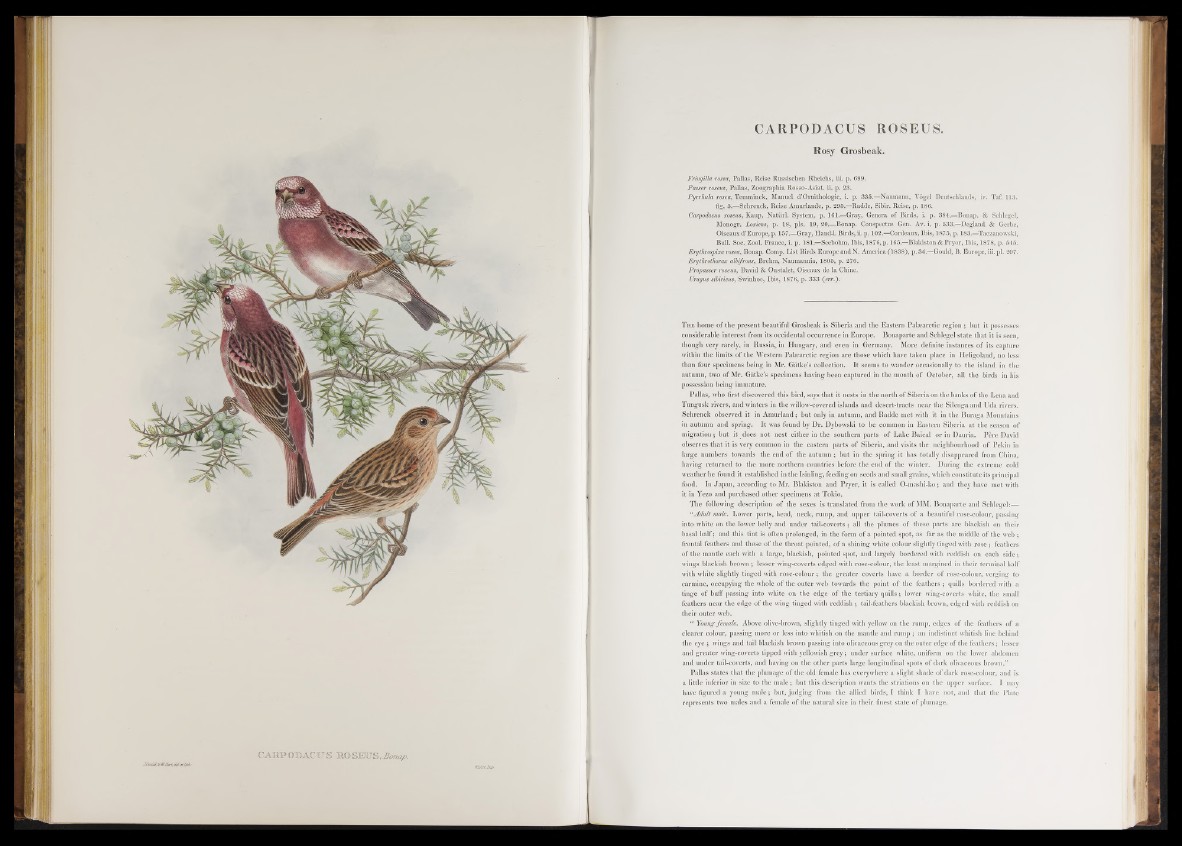
iTGcuU/bWllaridd'ttlieh-
CABPOBAcrrs r o s e u s ,
CARPODACUS ROSEUS.
Rosy Grosbeak.
Fringilla rosea, Pallas, Reise Russischen Rheichs, iii. p. 699.
Passer roseus, Pallas, Zoographia Rosso-Asiat. ii. p. 23.
Pyrrhula rosea, Temminck, Manuel d’Ornithologie, i. p. 335.—Naumann, Vögel Deutschlands, iv. Taf. 113.
fig. 3.—Schrenck, Reise Amurlande, p. 295.—Radde, Sibir. Reise, p. 186.
Carpodacus roseus, Kaup, Na tiirl. System, p. 161.—Gray, Genera o f Birds, i. p. 384.—Bonap. & Schlegel,
Monogr. Loudens, p . 18, pis. 19, 20.—Bonap. Conspectus Gen. Av. i. p. 533.—Degland & Gerbe,
Oiseaux d’Europe, p. 157.—Gray, Hand-1. B irds, ii. p. 102.—Cordeaux, Ibis, 1875, p. 183.—Taczanowski,
Bull. Soç.^Zool. France, i. p . 181.—Seebohm, Ibis, 1876, p. 165.—Blakiston & P ryor, Ibis, 1878, p. 545.
Erythrospiza rosea, Bonap. Comp. L ist Birds Europe and N. America (1838), p. 34.—Gould, B. Europe, iii. pi. 207.
Erythrothorax alhifrons, Brehm, Naumannia, 1805, p. 276.
Propasser roseus, David & Oustalet, Oiseaux de la Chine.
Uragus sibiricus, Swinhoe, Ibis, 1876, p. 333 (err.y.
T h e home of the present beautiful Grosbeak is Siberia and the Eastern Pakearctic region ; but it possesses
considerable interest from its occidental occurrence in Europe. Bonaparte and Schlegel state that it is seen,
though very rarely, in Russiav in Hungary, and even in Germany. More definite instances o f its capture
within the limits of the Western Palaearctic region are those which have taken place in Heligoland, no less
than four specimens being in Mr. Gatke’s collection. I t seems to wander occasionally to the island in the
autumn, two of Mr. Gatke’s specimens having been captured in the month of October, all the birds in his
possession being immature.
Pallas, who first discovered this bird, says that it nests in the north of Siberia on the banks of the Lena and
Tungusk rivers, and winters in the willow-covered islands and desert-tracts near the Silenga and Uda rivers.
Schrenck observed it in Amurland; but only in autumn, and Radde met with it in the Buraga Mountains
in autumn and spring. I t was found by Dr. Dybowski to be common in Eastern Siberia at the season of
migration; but it does not nest either in the southern parts o f Lake Baical or in Dauria. Pere David
observes that it is very common in the eastern parts of Siberia, and visits the neighbourhood of Pekin in
large numbers towards the end o f the autumn ; but in the spring it has totally disappeared from China,
having returned to the more northern countries before the end of the winter. During the extreme cold
weather he found it established in thelsinling, feeding on seeds and small grains, which constitute its principal
food. In Japan, according to Mr. Blakiston and Pryer, it is called O-mashi-ko; and they have met with
it in Yezo and purchased other specimens at Tokio.
The following description o f the sexes is translated from the work of MM. Bonaparte and Schlegel:—
“Adult male. Lower parts, head, neck, rump, and upper tail-coverts of a beautiful rose-colour, passing
into white on the lower belly and under tail-coverts; all the plumes of these parts are blackish on their
basal half; and this tint is often prolonged, in the form of a pointed spot, as far as the middle o f the web ;
frontal feathers and those o f the throat pointed, of a shining white colour slightly tinged with ro se ; feathers
of the mantle each with a large, blackish, pointed spot, and largely bordered with reddish on each sid e;
wings blackish brown ; lesser wing-coverts edged with rose-colour, the least margined in their terminal half
with white slightly tinged with rose-colour; the greater coverts have a border of rose-colour, verging to
carmine, occupying the whole o f the outer web towards the point o f the feathers; quills bordered with a
tinge of buff passing into white on the edge of the tertiary quills; lower wing-coverts white, the small
feathers near the edge of the wing tinged with reddish ; tail-feathers blackish brown, edged with reddish on
their outer web.
“ Young female. Above olive-brown, slightly tinged with yellow on the rump, edges of the feathers of a
clearer colour, passing more or less into whitish on the mantle and rump ; an indistinct whitish line behind
the eye ; wings and tail blackish brown passing into olivaceous grey on the outer edge of the feathers; lesser
and greater wing-coverts tipped with yellowish g rey ; under surface white, uniform on the lower abdomen
and under tail-coverts, and having on the other parts large longitudinal spots of dark olivaceous brown.”
Pallas states that the plumage of the old female has everywhere a slight shade of dark rose-colour, and is
a little inferior in size to the male; but this description wants the striations on the upper surface. I may
have figured a young male; but, judging from the allied birds, I think I have not, and that the Plate
represents two males and a female o f the natural size in their, finest state o f plumage.